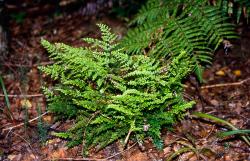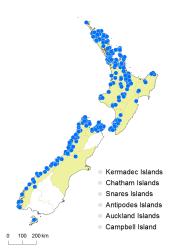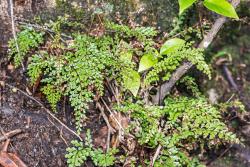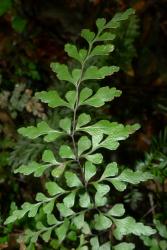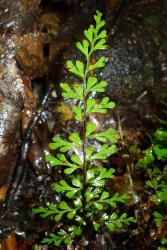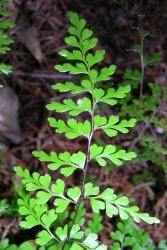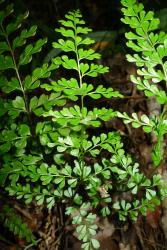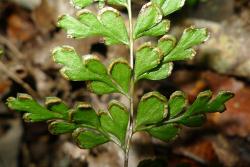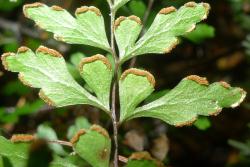- ≡ Adiantum trichomanoides (Dryand.) Poir., Encyc. Suppl. 1, 140 (1810)
- ≡ Schizoloma trichomanoides (Dryand.) Kuhn, Chaetopt., 346 (1882)
- = Adiantum cuneatum G.Forst., Fl. Ins. Austr. 84 (1786)
- ≡ Lindsaea cuneata (G.Forst.) C.Chr., Index Filic. 392 (1906) nom. illeg., non Lindsaea cuneata Willd. 1810
- = Lindsaea lessonii Bory in Duperrey, Voy. Monde, Crypt. 278, t. 37, f. 2 (1829)
- ≡ Lindsaea trichomanoides var. lessoni (Bory) Hook.f., Bot. Antarct. Voy. II (Fl. Nov.-Zel.) Part II, 19 (1854)
- ≡ Lindsaea cuneata var. lessonii (Bory) C.Chr., Index Filic. 395 (1906)
Rhizomes short- to long-creeping, up to 200 mm long (in herbarium specimens), 1–2 mm diameter, with stipes arising 1–15 mm apart; bearing scales. Rhizome scales narrowly ovate, 0.8–2 mm long, 0.2–0.5 mm wide, red-brown. Fronds monomorphic, 70–440 mm long, held upright. Stipes 20–240 mm long, red- or chestnut-brown, glabrous or with scattered scales proximally. Rachises chestnut-brown, sometimes becoming pale brown distally, very narrowly winged distally, glabrous. Laminae usually 2-pinnate to 2-pinnate-pinnatifid, rarely 1-pinnate-pinnatifid or 3-pinnate, ovate to narrowly ovate or narrowly elliptic to elliptic, tapering to a pinnatifid apex, 35–260 mm long, 15–100 mm wide, green on both surfaces, herbaceous, glabrous. Primary pinnae in 5–14 pairs below pinnatifid apex, widely spaced especially proximally, arising at a wide angle to the rachis and usually not overlapping, ovate or narrowly ovate; the longest below the middle, 9–90 mm long, 5–24 mm wide, apices acute or obtuse, bases short-stalked; proximal pinnae divided into one or more secondary segments or pinnae in the proximal half (except in the smallest fronds). Secondary pinnae gradually decreasing in length along each primary pinna to the distal end; the longest secondary pinnae ovate or elliptic or obovate, 4–18 mm long, 2–9 mm wide, apices acute or obtuse or rounded, bases stalked or sessile sometimes partly or completely divided into tertiary segments up to 6 mm long and 4 mm wide; the distal secondary pinnae obovate, elliptic or oblong or narrowly oblong, apices acute or obtuse, bases adnate. Sori more or less continuous around outer margins of ultimate segments; indusia extending laterally around lamina segments, curved, free margin entire or shallowly lobed.
Lindsaea trichomanoides is recognised by its monomorphic fronds with red-brown stipes and rachises. The laminae are very variable in shape and dissection – usually 2-pinnate to 2‑pinnate-pinnatifid, but sometimes only 1-pinnate-pinnatifid or as much as 3-pinnate. The primary pinnae arise at a wide angle to the rachis and rarely overlap. The ultimate segments are ovate to obovate with obtuse or rounded apices. The indusia curve around the margins of the ultimate segments with the free margin more or less entire.
North Island: Northland, Auckland, Volcanic Plateau, Gisborne, Taranaki, Southern North Island.
South Island: Western Nelson, Sounds-Nelson, Westland, Canterbury, Fiordland.
Stewart Island.
Altitudinal range: 10–1050 m.
Lindsaea trichomanoides occurs in lowland and montane areas throughout much of the North Island from Te Paki southwards, but is uncommon in the east. It extends from near sea level up to c. 1050 m on Mt Hauhungatahi but is rare above 750 m. In the South Island it occurs in the Marlborough Sounds, north-west Nelson, and along the West Coast to Fiordland and Stewart Island. It extends from near sea level to 600 m on the Heaphy Track, north-west Nelson. There is a collection from Bush Stream, Waimakariri (CHR 521359), which is the only precise record for the eastern South Island, although there is another from "Central Otago" (CHR 600330).
Also Australia (New South Wales, Victoria, Tasmania).
Lindsaea trichomanoides is a terrestrial fern found under kauri, podocarp, broadleaved and beech forest, or under mānuka and kānuka. It usually grows on the ground, or at the base of tree trunks, amongst tree roots, in litter or humus hummocks, on logs, on stream and track banks, or in damp gullies.
n = 42, 43 (Brownlie 1957, as Lindsaea cuneata).
The species was first recorded in New Zealand as Adiantum cuneatum (Forster 1786). However, the combination Lindsaea cuneata, made by Christensen (1905–1906) and used in earlier Floras, is preoccupied by L. cuneata (Willdenow 1810).
The name L. lessonii Bory has frequently been used at varietal rank for pinnate forms of L. trichomanoides. However, Kramer & Tindale (1976) and Brownsey & Smith-Dodsworth (2000) treated these forms as just part of the range of variation in L. trichomanoides.
Lehtonen et al. (2010) found no DNA sequence differences between L. trichomanoides and L. rufa Kramer from New Caledonia (Kramer 1967). The two species are also very similar morphologically, and their relationship requires further investigation.



